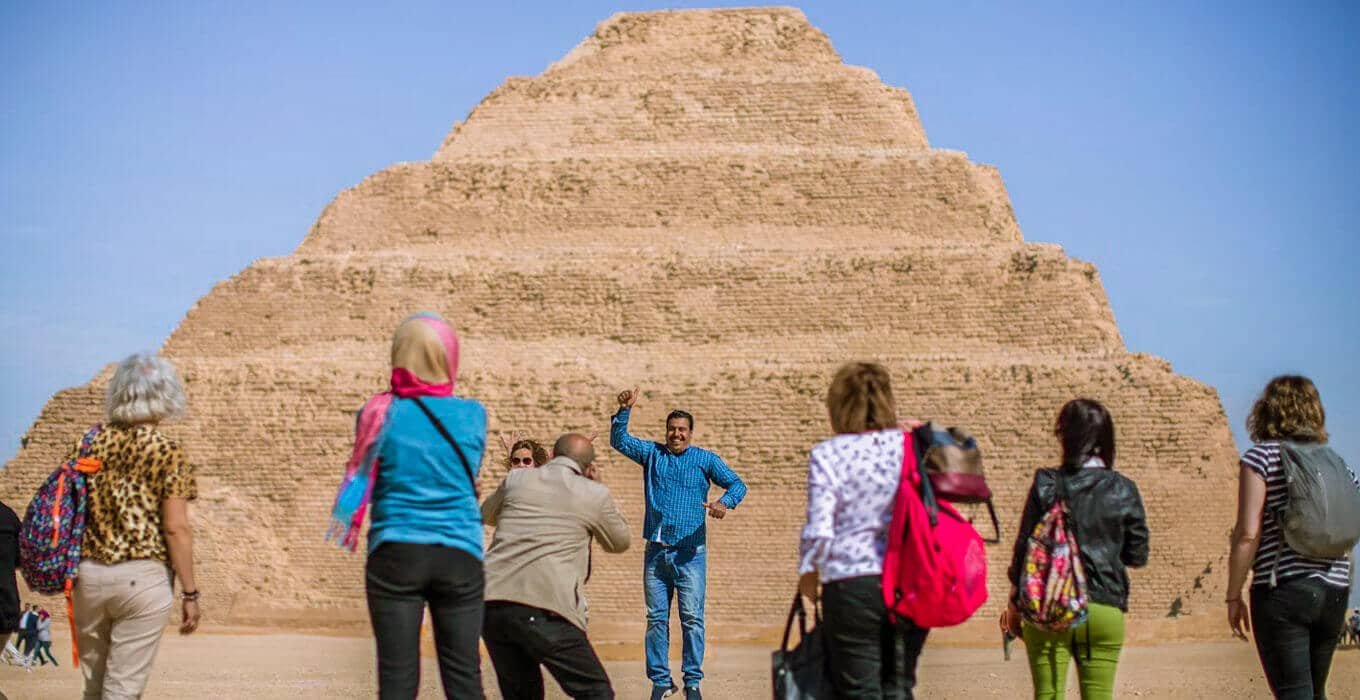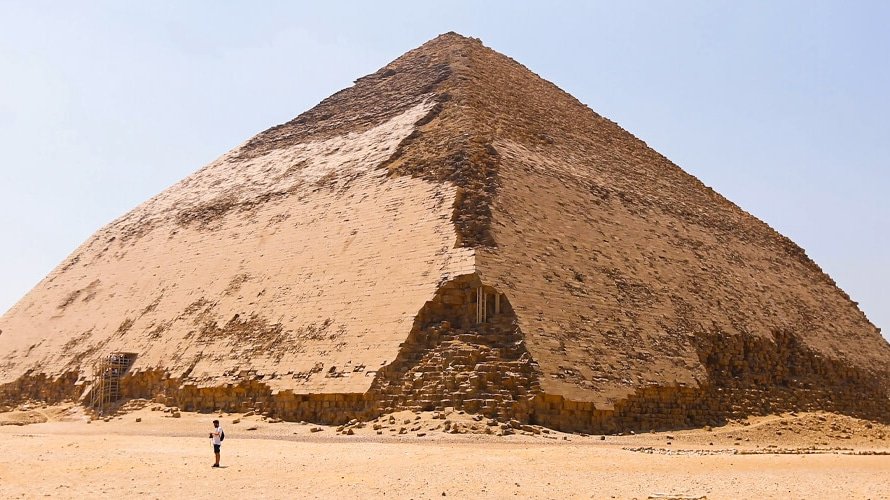Standing tall amidst the sands of Egypt, the Saqqara Step Pyramid is a testament to the ingenuity and ambition of the ancient Egyptians. As the oldest pyramid ever built, it marks a pivotal moment in the development of pyramid architecture, paving the way for the iconic wonders of Giza. Located in the vast necropolis of Saqqara, this revolutionary structure continues to captivate archaeologists and history buffs alike. Its unique stepped design reveals the evolution of ancient Egyptian funerary structures, showcasing the early steps of a civilization that would build some of the world’s most enduring monuments.
The History of the Saqqara Step Pyramid
The Saqqara Step Pyramid rises as a monument to the vision of Pharaoh Djoser, who ruled during Egypt’s illustrious 3rd Dynasty. Djoser’s reign marked a time of significant progress and innovation, and this ambitious construction project reflected his desire to create an eternal resting place of unprecedented grandeur.
The mastermind behind this architectural feat was Imhotep, Djoser’s vizier (chief advisor) and a man of remarkable talents. Imhotep was not only an architect but also a physician, priest, and scribe – a true polymath of the ancient world. He is revered as one of the key figures in the development of ancient Egyptian civilization.
The design of the Saqqara Step Pyramid was a radical departure from the traditional burial structures of the time. Before Djoser, kings and nobles were laid to rest in mastabas – flat-topped, rectangular tombs. Imhotep’s genius lay in transforming this concept by stacking multiple mastabas of decreasing size, creating the distinctive stepped form. This evolutionary leap in design represents the birth of the pyramid as we know it, setting a precedent for the mighty pyramids that would later dominate the Egyptian landscape.

Significance of the Saqqara Step Pyramid
- The Saqqara Step Pyramid does more than just impress with its size and unique form; it holds profound significance as a turning point in Egyptian funerary architecture. Before its construction, the simple mastaba was the standard burial structure for Egyptian royalty. By boldly transforming this tradition, Djoser and Imhotep established a new architectural language for the afterlife.
- Furthermore, the Saqqara Step Pyramid stands as the first large-scale stone monument in Egypt. Prior to this project, mudbrick was the primary building material for major structures. Imhotep’s decision to use stone revolutionized Egyptian construction techniques, demonstrating the potential for greater durability and monumentality.
- The experimental and innovative nature of the Saqqara Step Pyramid is essential to understanding its legacy. While not a ‘true’ pyramid with smooth sides, its stepped form served as a blueprint for later, more refined pyramids. The lessons learned at Saqqara, from engineering techniques to managing a massive workforce, directly contributed to the construction of the iconic pyramids at Giza. In this way, the Saqqara Step Pyramid is not just an architectural wonder in its own right; it’s the foundation upon which Egypt’s most famous monuments were built.
Features of the Saqqara Step Pyramid Complex
- The Saqqara Step Pyramid isn’t a standalone structure; it’s the centerpiece of a vast mortuary complex designed to serve the Pharaoh’s needs in both life and the afterlife. This sprawling complex offers a fascinating glimpse into ancient Egyptian rituals and architectural practices.
- A massive enclosure wall surrounds the complex, creating a sacred precinct. Within this enclosure, a large courtyard lies to the south of the pyramid. This open space would have been used for ceremonies and rituals related to the Pharaoh’s funerary cult.
- The complex also features various temples, including a mortuary temple where offerings were made to ensure Djoser’s well-being in the afterlife. Additionally, smaller tombs dot the area, belonging to members of the royal family and high officials, reflecting their closeness to the Pharaoh.
- One of the unique features of the Saqqara Step Pyramid complex is the Serdab. This small, enclosed chamber housed a statue of Pharaoh Djoser. Through small slits in the chamber, the statue was believed to ‘observe’ the rituals performed in the courtyard.
- The architectural style of the complex showcases the early development of stone construction in Egypt. Structures feature intricate details such as carved columns with papyrus and lotus motifs, symbolizing the natural world and the Pharaoh’s connection to it. While the complex exhibits a less refined aesthetic than later periods, it still reflects the craftsmanship and ingenuity of ancient Egyptian builders.
Visiting the Saqqara Step Pyramid
Experiencing the Saqqara Step Pyramid in person is an unforgettable journey into the heart of ancient Egypt. Here’s some essential information to plan your visit:
Location and how to get there:
- The Saqqara necropolis is located approximately 30 kilometers (19 miles) south of Cairo.
- Organized tours: The most convenient way to visit Saqqara is with an organized tour from Cairo. These tours often include transportation, a knowledgeable guide, and visits to other sites within the Saqqara complex.
- Taxi: You can hire a taxi for the day to take you to Saqqara and wait for you while you explore. Negotiate the price beforehand.
- Public transportation: It’s more challenging but possible to reach Saqqara using a combination of the Cairo Metro and microbuses.
Best times to visit:
- To avoid the largest crowds and intense heat, aim to visit Saqqara during the cooler months (October to April).
- Arrive early in the morning or later in the afternoon for the best light and fewer people.
Ticket prices and opening hours:
- Ticket prices vary depending on whether you want to enter the pyramid itself. Check the official website or your tour operator for the latest pricing.
- The Saqqara complex is typically open daily from morning to early evening.

Advice on how to dress and other things to bring:
- Dress modestly: Egypt is a conservative country, so cover your shoulders and knees.
- Comfortable shoes: You’ll be walking on uneven ground and possibly entering the pyramid.
- Sun protection: Hat, sunglasses, and sunscreen are essential.
- Water: Stay hydrated, especially if visiting during the warmer months.
- Camera: Capture the breathtaking sights!
FAQs
How old is the Saqqara Step Pyramid?
The Saqqara Step Pyramid was built around the 27th century BC, making it approximately 4,700 years old. This places its construction at the dawn of Egypt’s dynastic period.
Who built the Saqqara Step Pyramid?
The Saqqara Step Pyramid was built for Pharaoh Djoser, who reigned during Egypt’s 3rd dynasty. The visionary architect and polymath Imhotep is credited with designing the revolutionary structure.
Can you enter the Saqqara Step Pyramid?
Yes, it’s possible to enter the Saqqara Step Pyramid. Visitors can descend into the interior passageways and reach the burial chamber deep within the pyramid. However, please note that access might occasionally be restricted for maintenance or restoration work.
What else is there to see in Saqqara?
Saqqara is a treasure trove for ancient Egyptian history enthusiasts. The sprawling necropolis contains numerous other pyramids, including the Pyramid of Teti, fascinating tombs with intricate artwork, the remains of temples, and the Imhotep Museum dedicated to Saqqara’s history.
Is a guided tour of Saqqara recommended?
While you can explore the Saqqara complex independently, a guided tour is highly recommended. A knowledgeable guide will enrich your experience by providing historical context, explaining the significance of the various structures, and helping you navigate the site efficiently.
Conclusion
The Saqqara Step Pyramid stands as a testament to the ambition and architectural brilliance of a civilization at the cusp of greatness. Its imposing form reveals the evolution of funerary practices and the birth of Egypt’s iconic pyramids. From the vision of Pharaoh Djoser to the genius of Imhotep, the Saqqara Step Pyramid marks a pivotal chapter in human history.
For anyone fascinated by ancient Egypt, Saqqara is an unmissable destination. To walk in the shadow of this groundbreaking pyramid is to connect with the origins of a civilization that left an indelible mark on the world. It’s a place that ignites the imagination and fuels a desire to delve deeper into the mysteries of the past.
So, whether you’re a seasoned traveler or a curious explorer, let the Saqqara Step Pyramid be your gateway to the wonders of ancient Egypt. Embrace the opportunity to discover its secrets, and perhaps you’ll unlock a part of yourself that yearns to connect with the extraordinary achievements of our ancestors.
Related Article to Read:







